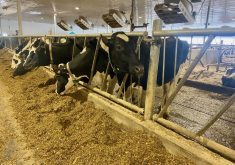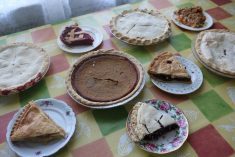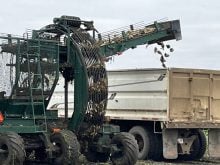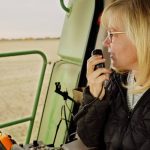HAYWOOD, Man. – Pam de Rocquigny remembers vividly having to brush off her future husband, who approached her at a bar in St. Claude, Man., one night in 2001 when she was wearing her cousin’s volunteer fireman’s coat.
“He came up and asked: ‘who’s the sexy new firefighter in town?’
“I just glared at him, thought ‘whatever,’ and walked away. That was the first time we met.”
A few months later she went out on a date with Norbert, who had run into her again, but whom she didn’t recall from the St. Claude incident until halfway through their dinner date.
Read Also

Accurate accounting, inventory records are important
Maintaining detailed accounting and inventory records is not just a best practice; it’s a critical component of financial health, operational efficiency and compliance with programs like AgriStability.
“I couldn’t believe it,” she said about her sudden realization that it was the same man. “I hadn’t put two and two together that this was the guy who had given me that cheesy pickup line.”
Fortunately he had time to make a better impression so the date turned into a relationship.
“The first time I struck out. The second time was better,” said Norbert with a smile after hearing Pam tell the story of their meeting.
They were married a year later and now live on a beef farm outside of Haywood, Man. Their son Sammy, was born in August 2004.
The de Rocquignys have had to overcome a number of obstacles like their initial meeting in order to make a go of forming a family and creating a sustainable life in the country. But they’ve managed to work through the challenges of modern rural living to get a start that they feel good about.
“I’m happy,” said Pam, who is Manitoba Agriculture’s business development specialist for feed grains in Carman, a half-hour drive from the farm.
Norbert is going through the heavy demands of calving right now. About half of the farm’s 70 cows are purebred Simmentals and they start calving in January. He also works on a St. Claude dairy farm, but beginning in January has reduced his hours. He has worked at the dairy farm for 12 years, doing the first milking at 6 a.m. and the second at 4 p.m.
Norbert and Pam have a well-choreographed schedule that allows each to get to their jobs on time and also take care of Sammy. Norbert has been doing the first milking, then comes home for 8 a.m. to feed Sammy and take him to day care while Pam heads to her job in Carman.
While it may be a busier routine than some farm families face, Pam said they want to farm, so they need the jobs.
She took a year-long maternity leave when Sammy arrived, but by the end was ready to return to work.
“It was so much fun, but I knew I had to go back because we were buying the farm,” said Pam, who returned to work in August 2005.
Norbert had lived in their present farmhouse since 1985 when a tornado wiped out the family’s old farmhouse. He and Pam had planned to first buy or build a house nearby and eventually take over the farm when his parents retired, but his dad sped things along.
“He said, ‘why don’t you buy the farm from us?’ “
Norbert’s parents had planned to slowly ease out of farming over two or three years, so Pam and Norbert’s need for a new home fit in quite well.
Better, in fact, than anyone had planned, because Norbert’s father had a heart attack last spring just as they were finalizing the sale, and would have needed to move into town anyway.
“It saved a bit of work for everyone,” said Pam.
Norbert oversees the herd of 70 cows, of which seven are owned by his father, who still helps out on the farm.
He tends to sell two to five bred heifers in the fall, sells about two yearling bulls every spring, and sells the rest of the calves off the cow in the fall.
Fortunately for the family, most of their income was not coming from beef cattle during the BSE crisis. The border closure made the future look bleak, but they were not in danger of going broke like other farm families.
“The farm has been just sort of a side thing for both of us, really,” said Norbert, 31. The end of the crisis has allowed him to invest more time and effort into the beef operation, and now he’s beginning to turn it into his major endeavour.
“It’s more of a full-time thing now,” said Norbert.
“With both of us having jobs, I wouldn’t say BSE hurt us, but we were able to keep going. Without jobs, we couldn’t have done anything.”
Pam is thrilled to have a job in Carman, which is near her parents’ farm. But when she first went away to the University of Manitoba, ending up in rural Manitoba was not her goal.
“I said ‘I’m never coming back to a small town,’ ” said Pam, laughing at her rejection of everything she loves now.
“It’s funny how things work out. As you get older you realize some things. I’m a homebody. I like being near my mom and dad.”
Fortunately for Pam, the Manitoba government moved much of the agriculture department’s extension work to Carman years ago. But after getting her agriculture degree she didn’t immediately return home. She got a job as a Cargill representative in Swan River, Man., which took her far from family and made her conscious of their absence.
She began to think about trying to get a Manitoba Agriculture job in Carman, but realized the department generally required people to have master’s degrees. So she went back to the university, got her graduate degree, and was hired as a special crops agronomist in 2001.
While she was on maternity leave the department radically revamped its offices and job descriptions, and she came back as a feed grains specialist.
“I like extension, working with farmers,” she said.
Norbert always wanted to farm and went straight from high school to working on the dairy farm. His parents pushed him to go to Olds College in Alberta to study herd management, but “it didn’t really excite me. I wanted to start working right away.”
Now he wonders if he should have listened to them.
“Maybe I’d know a few more tricks,” he said.
Sammy has already begun his agricultural education. He constantly watches an animated farming video his grandparents gave him for Christmas and loves anything to do with machines or animals. He loves hugging his teddy bear, but Pam said she makes sure he doesn’t try to get a hug from the furry creatures outside.
“We watch him really carefully to make sure he doesn’t get outside near the cows. If he had his way he’d go right in there,” she said. “He thinks they’re all big furry friends.”















